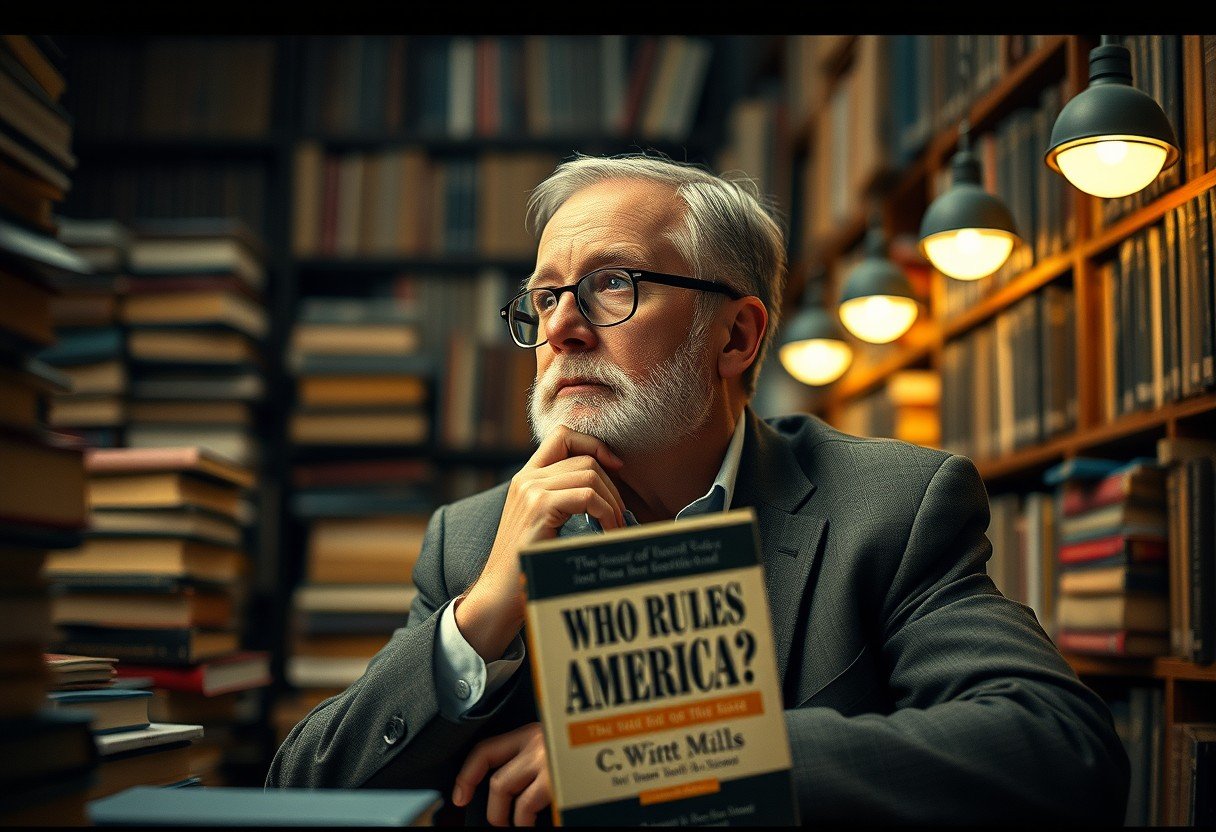C. Wright Mills studied how a small group holds power in the United States, where they act, how they connect, and why this matters for democracy. He wrote in the mid twentieth century, but his ideas help explain today. You will learn who the key thinkers are, what they argued, when these books appeared, and how to use these ideas to read the news with a sharper eye.
What The Power Elite Means
The power elite is a small circle of leaders in business, government, and the military who shape major choices that affect everyone. They meet in boardrooms, in Washington, and inside large institutions where decisions move fast.
Mills argued that top roles in the economy, politics, and the armed forces are linked, and that this link gives a few people outsized influence. He called attention to shared schools, clubs, and careers that keep this circle tight.
These leaders do not control every detail of life. But when big questions arise, like war and peace or rules for money and markets, the same names often appear near the center. That pattern is the key idea behind elite theory.
For readers today, the concept is a tool. It helps you ask who sits at the table, how they got there, and whose interests are heard when choices are made.
Who Wrote The Key Books On Elites
C. Wright Mills wrote The Power Elite in 1956, which set the classic view of elite networks in the United States. He focused on how corporate chiefs, political leaders, and military commanders overlap.
G. William Domhoff wrote Who Rules America in 1967 and has updated it many times. His work maps how wealth, policy groups, and social ties guide power in modern life. Many readers use both books together because they fit well.
Both writers study how money, status, and organization shape outcomes. They differ in methods and details, but they share a clear question that still matters. Who decides the biggest choices, and how can citizens respond.
Knowing the correct authorship helps you search the right book for the right claim. It also improves your trust in sources when you read elite theory summaries online.
How The Elite Network Works In Real Life
In practice, power networks form through repeat ties. People move from one top role to another and carry contacts, trust, and know how with them.
Researchers point to interlocking directorates, policy think tanks, and the revolving door between public office and private firms as key channels. These channels keep ideas and influence flowing.
- Interlocking boards let a small set of directors sit on many large companies at once, linking corporate plans.
- Policy groups host task forces that write model rules later used by lawmakers and agencies.
- Lobbying and campaign money shape which bills get time, edits, and votes in key committees.
Lobbying spending in the United States totals over 4 billion dollars a year, and the largest sectors account for most of that sum. That spending concentrates pressure where it counts most, such as tax rules, trade, and tech regulation.
Media ownership and elite education also matter. Graduates of a few schools fill many top jobs, and a few firms own many news outlets. These patterns raise questions about voice, diversity, and agenda setting.
Why This Matters For Democracy And Inequality
Power concentration can mute the voices of ordinary voters. When leaders meet in tight circles, new ideas and local needs can be left out.
Elite control can tilt rules toward wealth, which widens gaps in income and assets over time. Today, the top one percent holds about one third of United States household wealth.
When people feel their vote does not change results, turnout falls and trust fades. That cycle harms public debate and makes capture easier the next time. It is a feedback loop.
Good civic design can blunt these risks. Strong disclosure, anti corruption rules, fair district maps, and active local media all help open the system and invite more voices.
Key Works At A Glance
This quick view helps you match each core book to its main idea and time.
| Author | Title | Year | Main Focus | Big Idea |
|---|---|---|---|---|
| C. Wright Mills | The Power Elite | 1956 | Links among corporate, political, military leaders | A small, connected circle steers major national decisions |
| G. William Domhoff | Who Rules America | 1967 and updates | Wealth, class, policy networks, social clubs | Organized upper class shapes policy and public opinion |
Use these titles for deeper study. Pairing them gives you both classic theory and a map of modern networks with case studies and data.
Ways To Think Critically About Power Today
Anyone can build a simple habit to read power in the news. Start by asking the same questions every time you see a big decision.
- List who is at the table, then look up their past roles, boards, and donors.
- Track the policy path from a think tank paper to a bill to a rule to a contract.
- Follow the money by reading disclosures, tax notes, and agency dockets.
Small steps like these turn a headline into a map of people, money, and rules. Over time you will see repeat ties and patterns.
Community action grows from clear maps. Share what you learn with local groups, ask for records, and speak at meetings. Better facts build better claims, and better claims build trust.
Common Critiques And Support Of Elite Theory
Critics say power is more plural today. They point to social movements, court wins, and the rise of new industries that shift who has clout.
Supporters answer that even when names change, tight networks remain. Big donors, large firms, and security groups still shape many outcomes at key moments.
The truth can include parts of both views, which is why evidence and open data matter. We can test claims by counting links, money flows, and policy wins across time.
Healthy debate improves the research record. Clear methods and public datasets let anyone check the work and repeat the test.
Lasting Influence On Sociology And Politics
The ideas from Mills and Domhoff changed how scholars study power. They led to new work on interlocks, campaign finance, and policy networks.
Elite theory now shapes research, classroom teaching, and public talk about class, race, and state power. It offers a frame for stories on tech giants, energy firms, and defense policy.
These books still sell because they help people connect private troubles to public issues. Readers learn how decisions far away can set the rules close to home.
If you want to go deeper, read both books in full. Then test their claims in your city or field of work to see what holds and what needs a new frame.
FAQ
Did C. Wright Mills Write Who Rules America?
No. C. Wright Mills wrote The Power Elite in 1956. G. William Domhoff wrote Who Rules America in 1967 and keeps updating it.
What Is The Main Idea Of The Power Elite?
The book says a small, linked group in business, politics, and the military guides major national choices. It explains how shared backgrounds and roles keep that circle tight.
What Does Who Rules America Focus On?
It maps how the upper class, policy groups, and media shape rules and public views. It uses case studies and data to show how influence works.
Why Is Elite Theory Still Relevant Today?
Big decisions still flow through a few centers of money and organization. Understanding these links helps citizens push for fair rules and real accountability.
How Can I Use These Ideas When Reading News?
Ask who benefits, who pays, and who decides the timing. Then check board seats, donors, and think tank ties to see the network behind the story.
Does Elite Power Mean Democracy Cannot Work?
No. It means democracy needs strong guardrails like transparency, fair maps, and open records. With these tools, more voices can shape outcomes.









Leave a Comment